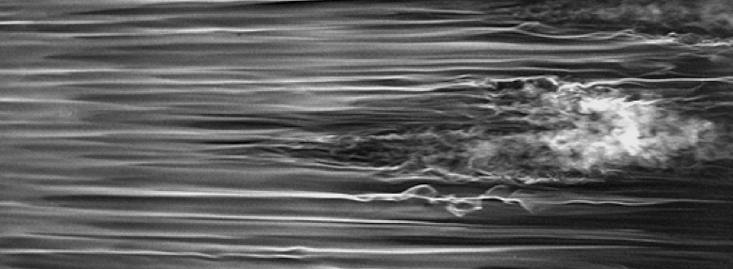Stability and Control
Introduction
One of the oldest areas in fluid dynamics is that of stability of laminar flows and the breakdown to turbulence in wall bounded flows. In 1883 Osborne Reynolds performed a famous pipe flow experiment investigating the stability and transition of that flow. Theoretical approaches, which were formulated around 1910, could predict exponential instabilities, but utterly failed for the pipe flow experiment, since no exponential instability exists for that case. Many other flow cases of both fundamental and technical importance have been just as difficult to analyze with the traditional theories of exponential growth of disturbances.

Figure 1: Wind tunnel smoke visualization of transition in a boundary layer subjected to free stream turbulence carried out at KTH. The figure shows the development of streamwise streaks, secondary instabilities and the breakdown to a turbulent spot. The flow is from left to right
Research overview
The direction of our research in the area of stability and transition of fluid flows is towards enhanced physical understanding of the receptivity mechanisms, stability in complex geometries and further understanding of classical stability problems.
Receptivity. Boundary layer disturbance receptivity is an area where we both have experimental and numerical activities. The geometries adopted here are plane leading edge and swept leading edge with the possibility to vary the external pressure gradient in order to simulate cross flow instabilities in 3D boundary layers. The current goals in this area are:
- To gain knowledge in experimental roughness implementation techniques
- Advance three component LDV measurements.
- To undrestand and quantify both surface roughness and leading-edge receptivity.
- To numerically and experimentally investigate the correlation between free-stream turbulence characteristics to boundary layer transition.
Stability in complex geometries. A new direction of stability research is the investigation of stability of flows in complex geometries using both experiments and DNS. For example, an optimal superposition of global modes can often reveal more complex disturbance behaviour than single eigenmodes, e.g. large transient growth of wave-packets and great sensitivity to forcing. A large activity within FLOW is in the area of wind turbine wakes. The focus is on wake interaction and tip-vortex breakdown. The current goals of the stability in complex geometries area are:
- To study the disturbance behaviour in complex 3D flows by using a global mode approach. Examples of the flow of interests are hydrodynamic stability of a jet in cross-flow, curved pipe flows, separated flows and three-dimensional modes in rotating boundary layers.
- To develop methods for direct numerical simulation of transitional flows in complex geometries.
- To numerically and experimentally investigate the instability and control of structures in boundary-layer over wings, wind turbine and compressor blades.
- To experimentally and numerically study the tip-vortex breakdown generated by wind turbine rotor blades and the wind turbine wake interactions.
Research environment
A distinguishing mark of the active groups (including here the flow control group with overlapping research interest) is the interplay between theoretical, numerical and experimental research, where similar problems are attacked with different methods.
Research groups
- Group of Dan Henningson
- Group of Henrik Alfredsson
- Group of Jens Fransson
- Group of Luca Brandt
- Group of Philipp Schlatter
Facilities
- The Minimum-Turbulence-Level ( ) wind tunnel, which was inaugurated in 1990, has proven to be a world-class resource for advanced transition and stability as well as turbulence research.
- FLOW centre has access to the different super-computer resources managed by the Swedish Centre for Infrastructures ( SNIC ).
Collaborating organizations
ONERA, DLR, ITAM, Imperial College, Stuttgart Univ., Marlbourgh Univ., Darmstadt Univ., Genoa Univ., Salerno Univ., Univ. of Illinois at Urbana-Champaign, ...
Key publications
- Brynjell-Rahkola, M., Shahriari, N., Schlatter, P., Hanifi, A. & Henningson, D. S. (2017) Stability and sensitivity of a cross-flow-dominated Falkner–Skan–Cooke boundary layer with discrete surface roughness, Journal of Fluid Mechanics 826, 830-850, 2017
- Vernet, J.A., Örlü, R. & Alfredsson, P.H. 2018 Flow separation control behind a cylindrical bump using DBD-VGs plasma actuators. J. Fluid Mech. 835, 852-879.
- Appelquist, E., Schlatter, P., Alfredsson, P.H. & Lingwood, R. 2018 Transition to turbulence in the rotating-disk boundary-layer flow with stationary vortices. J. Fluid. Mech. 836, 43-71.
- Canton, J., Schlatter, P., & Örlü, R. (2016). Modal instability of the flow in a toroidal pipe. Journal of Fluid Mechanics, 792, 894-909.
- Duguet, Y., Schlatter, P., Henningson, D. S., & Eckhardt, B. (2012). Self-sustained localized structures in a boundary-layer flow. Physical review letters, 108(4), 044501.

